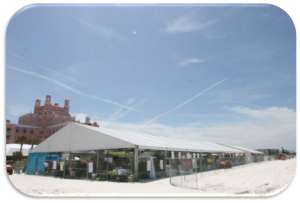It’s convention season in the south and like every year the tents start popping up all over. Every major convention hotel and even our massive 7,000,000 square foot Orange County Convention Center becomes tent city – gleefully ready to accommodate the ever-growing group sizes.
In my 20 plus years of event production I’ve had more than my fair share of tent installations, tent decorating and a few tent troubles. Everything from managing a massive 50,000 square foot structure install at a major resort that included moving power lines and leveling 50 year old trees to small beach-side VIP cabanas (just because they are cute and tiny doesn’t mean they can’t bite).

1. Site Selection: Tents can seemingly go up anywhere now days: beaches, rooftops, even the side of a mountain. Make sure you define a clear path for load in and load out, tent parking area, equipment staging area and if you’re staking the tent, have the area checked thoroughly for power and cable lines, irrigation pipes and water mains.
Tip: Know that if you are covering real grass for any length of time, it will die without sunlight and water; determine ahead of time that there will be no “replacement of grass fee” or negotiate what the replacement of sod or seeding fees will be. Same goes for the bushes someone in a truck will drive over.

2. Permitting: Warning: If the tent company your taking bids from doesn’t talk about permits or ask hard questions about insurance and site selection – RUN don’t walk away from that prospected vendor. Most reputable tent companies have great relationships with all the governing lawmakers over their area and most will offer to get all permits for you.
3. Restrictions: Check every municipality including, state, county, city, association, neighborhood and owner. You’d be surprised how much they differ in their rules and opinions about what is allowed and what’s not.
Tip: Cost Control on Restrictions: Find out if you have any building time and noise restrictions codes where you want to install the structure. If you’re not allowed to work into the evenings, this could extend the days of your installation costing you more than 3x your labor projected costs.

4. Anchoring Procedures: Make sure to follow the letter of the law on the type of anchoring required and acceptable for the size, shape and location of your tent.
5. Insurance: Double Down – Never skimp on insurance when doing events in tents. Make sure all your basis are covered included event insurance, structure insurance and insurance for site location property owners.

6. Hurricanes, Tornados and Acts of God OH MY!: With incoming season changes come incoming changing weather conditions. Read the contract, get out the Farmers Almanac and pray. Know exactly the policies and procedures that the tent vendor has that they will, have the right and need for safety first to come and take down your tent. FYI – Installing a tent with gusts of wind of 30 miles per hour is scary stuff and it will slow your install down.

7. Design Trend: Double Deckers are IN! If you have the time, money and guts, a tent that has some character with two floors or an open balcony give guest a birds eye view and they love it! This awesome double-decker tent is from TSE 2012.

8. The Floors: Got to have it! Carpet is so yesterday – it’s all about the “hardwood floors”, tiles or seamless black patent leather!

9. Paint it with Light: A tent is like a giant canvas that looks best when painted in light. Animated image projection uses light to create a masterpiece of moving images.

10. Shape it Up: The usual tent shapes are round or have giant peaks. Try to create something out of the ordinary. The “pavilion” over at the Grand Hyatt Airport in Tampa is an interesting oval and round combo that makes it fun to dress in light. The picture above is the Air-star America Dome; it’s one of my favorite tent structures.